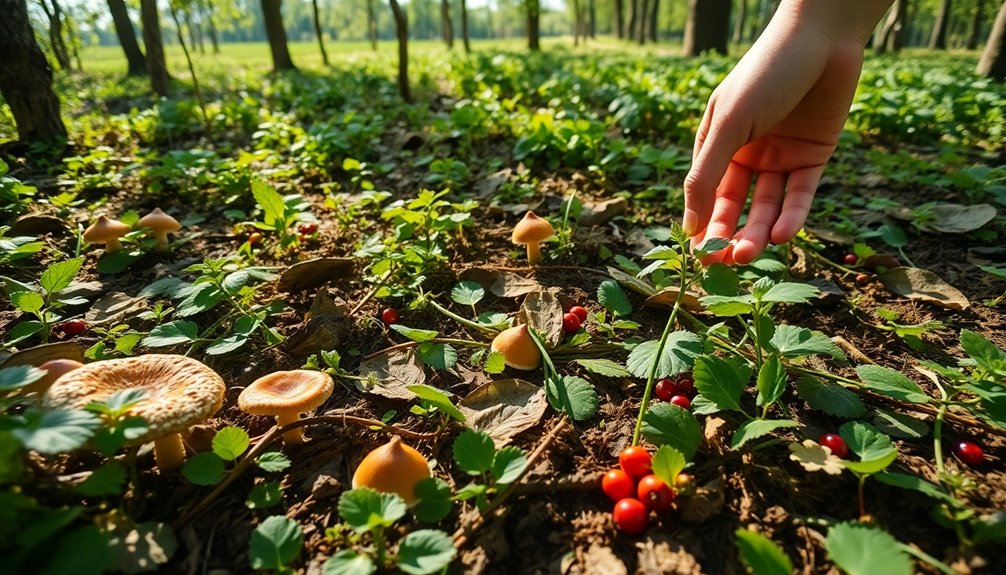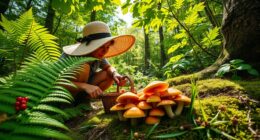You can conclude that habitat quality directly influences foraging behavior and success. The data shows that animals adapt their strategies to optimize energy gain according to resource availability. In productive environments, species tend to be more selective, while in less fertile areas, they broaden their diets for flexibility. This adaptability highlights the importance of habitat health in supporting biodiversity. Effective foraging not only impacts individual fitness but also ecosystem stability. You'll find that further exploration into these interactions reveals even deeper insights into the vital balance of nature.
Key Takeaways
- Habitat characteristics directly influence foraging behavior, with resource availability shaped by environmental factors impacting species' dietary choices and efficiency.
- Increased energy costs in less productive habitats lead to broader diets, while productive environments encourage selective foraging for higher energy rewards.
- Seasonal changes necessitate adjustments in foraging strategies, highlighting the importance of habitat structure and resource fluctuations on animal behavior.
- Effective foraging correlates with habitat health; diverse ecosystems support multiple trophic levels, enhancing reproductive fitness and survival rates.
- Habitat preservation is crucial for maintaining biodiversity and foraging efficiency, as habitat loss significantly reduces food resource availability and increases energy expenditure.
Importance of Foraging Behavior

Why is foraging behavior so vital for animal survival? Foraging behavior involves acquiring energy from food sources, which directly affects reproductive fitness and overall population dynamics.
By understanding the benefits of nutrition, you can see how important it's for animals to find food efficiently. Successful foragers adapt through natural selection, minimizing the costs of obtaining resources while maximizing energy gain.
Optimal Foraging Theory illustrates that animals aim to maximize net energy intake per unit time, demonstrating the trade-offs between foraging efficiency and essential activities, like avoiding predators.
For instance, when animals engage in Central Place Foraging, they strategically return to a specific location for food, optimizing energy gain based on travel distance and the quantity of food they can bring back.
Your observations of species-specific strategies, such as gulls dropping clams from heights, reveal how adaptable animals can be in their foraging behavior.
Understanding these dynamics not only highlights the importance of foraging behavior but also emphasizes the delicate balance between energy acquisition and survival.
Therefore, foraging behavior stands out as a fundamental aspect of life in the animal kingdom.
Insights From Foraging Data

Analyzing foraging data reveals crucial insights into how animals interact with their environments. You'll notice that habitat characteristics play a significant role in foraging behavior. Successful foragers often select areas that maximize energy intake while minimizing predation risks. When the environment is less productive, predators may need to broaden their diets to meet energy needs, indicating that selection should favor flexibility in prey choices.
Observational data, like that from gulls, illustrates how foraging patterns reflect resource availability and habitat utilization over time. Central place foraging strategies emphasize the importance of specific locations for food retrieval, impacting energy allocation for travel and overall foraging efficiency. Here, nutrition and costs become critical factors in the decision-making process.
Additionally, statistical analyses, such as chi-square tests, can assess the randomness of foraging behaviors. This helps you understand the ecological dynamics and habitat preferences of various foraging species.
Optimal Foraging Theory Explained

When you consider foraging, think about how animals optimize their energy intake.
They make trade-offs between finding food and avoiding predators, shaped by natural selection. This balance leads to various strategies, whether they're generalists with diverse diets or specialists targeting specific prey.
Energy Maximization Strategies
Ideal Foraging Theory suggests that organisms, from tiny insects to large mammals, strategically seek to maximize their net energy intake while foraging. This involves a compromise between benefits and the time spent foraging. Foragers assess their surroundings, balancing energy costs with nutritional rewards.
| Foraging Strategy | Key Characteristics |
|---|---|
| Generalists | Diversify diet; target prey with short handling times. |
| Specialists | Focus on specific prey types; accept longer handling times for higher rewards. |
| Less Productive Environments | Broaden dietary breadth to optimize energy intake. |
| More Productive Environments | Selective foraging due to abundant resources. |
As you consider these strategies, think about how natural selection favors foragers that effectively manage time and energy. For example, central place foraging highlights how travel distances can impact energy maximization. When food availability diminishes, organisms adapt their foraging behavior to guarantee survival. By understanding these energy maximization strategies, you can gain insight into how different habitats influence foraging behaviors and the overall ecological balance. Additionally, just as educational toys can stimulate cognitive growth in children, effective foraging strategies enhance an organism's ability to thrive in its environment.
Trade-offs in Foraging
Understanding the balance between energy intake and the costs of foraging is key to grasping Ideal Foraging Theory. You'll find that organisms aim to maximize their net energy intake per unit of time, weighing the benefits of food acquisition against the costs involved in foraging.
Trade-offs in foraging behavior are essential; they involve considering the time spent searching for food versus handling and consuming it. Efficient foragers minimize their overall foraging time.
Generalist foragers often choose prey with short handling times, allowing them to quickly maximize energy intake. In contrast, specialists might focus on prey with longer handling times that provide higher nutritional value.
The environment plays a significant role here; in less productive areas, predators might broaden their diets to boost energy intake, while those in more productive environments can afford to be more selective.
Ultimately, the efficiency of these foraging strategies is shaped by natural selection, which favors individuals that optimize energy intake while minimizing risks, such as predation.
Understanding these trade-offs can give you valuable insights into the foraging behavior of different species and their adaptability to varying habitats.
Natural Selection Influence
Natural selection plays an essential role in shaping foraging behavior through Ideal Foraging Theory, which suggests that animals endeavor to maximize their net energy intake while minimizing effort.
This theory emphasizes that you, as an organism, will evaluate the nutritional benefits of food against the costs of obtaining it, like time and energy spent searching and handling. It's all about efficiency.
Trade-offs are key in foraging; for instance, while hunting or gathering, you might've to balance your efforts with the risk of becoming prey.
Generalist foragers, who can exploit a variety of food sources, tend to have shorter handling times, making them more adaptable in diverse environments. In contrast, specialists may focus on specific food types that require longer handling times but offer higher energy returns.
Moreover, environmental factors, such as habitat productivity, greatly impact your foraging strategies.
In more productive environments, you often exhibit selective feeding behaviors, targeting higher-quality food sources.
This adaptability is a product of natural selection, favoring those who can efficiently navigate their surroundings to optimize energy intake.
Ultimately, your survival hinges on these finely-tuned foraging strategies shaped by natural selection. Additionally, the availability of food resources, influenced by foraging range, can significantly dictate foraging success and efficiency.
Strategies for Effective Foraging

When you're foraging, it's crucial to use techniques that boost your efficiency and energy intake.
The type of environment you're in can greatly influence your strategies, pushing you to adapt based on food availability.
Understanding these factors can help you maximize your foraging success.
Foraging Efficiency Techniques
Foraging effectively means balancing the time spent searching for food with the time it takes to capture and consume it. To maximize your foraging efficiency, focus on minimizing both waiting time and handling time. When you're out there, opt for prey that requires less handling; this is especially important for generalists. Additionally, integrating traditional healing practices can enhance your understanding of the nutritional benefits of various wild edibles. Chia seeds, for instance, are a great option for foragers due to their high nutritional value and ease of cultivation.
Remember, the Ideal Foraging Theory suggests that you should target food sources offering the highest net energy gain. For instance, understanding the forage quality test reports can help you evaluate the nutritional value of your finds. In regions like Minnesota and Wisconsin, you can find a rich diversity of wild edibles that can enhance your foraging success, including blueberries and dandelion greens.
Adapt your strategies based on what's available in your habitat. In less productive environments, you might need to adopt a generalist approach, while in more productive areas, you can afford to be choosy.
If you're practicing Central Place Foraging, keep in mind the importance of minimizing travel distance when returning to your location. This can greatly impact your food selection and overall efficiency.
Be adaptable! You may need to switch prey types based on energy costs and potential risks. This flexibility in your foraging strategies won't only enhance your energy intake but also improve your survival and reproductive success. Additionally, understanding the best woods for tables can help you create a more sustainable foraging setup by utilizing locally sourced materials for your needs.
Environmental Influence on Foraging
The effectiveness of your foraging strategies largely hinges on environmental factors that shape resource availability. If you're in a productive ecosystem, you might adapt a generalist approach, diversifying your diet to take advantage of the variety available. In contrast, if you find yourself in a less productive area, specializing in specific prey can enhance your foraging success.
Optimal foraging theory guides your choices, suggesting you'll maximize energy intake by selecting food sources offering the best nutritional value with minimal effort. Travel distance and prey handling time are vital factors in this equation. Raw food can sometimes be a vital resource that enhances nutrient intake in certain ecosystems. Additionally, incorporating STEM toys can provide engaging ways to simulate foraging behaviors, offering both mental stimulation and educational value. Furthermore, the use of self-watering pots can create a sustainable environment that supports plant growth, contributing to overall resource availability. Understanding the principles of sustainable living can further enhance your foraging practices by promoting biodiversity and environmental health.
Furthermore, habitat structure and competing species can force you to adjust your strategies, helping you minimize predation risk while maximizing food acquisition efficiency.
Consider central place foraging, where you'll return to a specific location after each trip. This behavior illustrates the balance between energy gained and travel costs, evident in species like the European Bee-eater.
Seasonal changes in resource availability also prompt shifts in your foraging behavior, pushing you to modify strategies according to fluctuating food sources and environmental conditions to guarantee your survival and reproductive success. For instance, the use of foraging toys can enhance mental stimulation and encourage natural behaviors in various species, making it essential to consider animal welfare in your foraging strategies.
Adaptation is key in the ever-changing landscape of foraging.
Energy Costs in Habitat Selection

Energy costs play a pivotal role in how animals choose their habitats. When evaluating potential environments, you need to take into account the trade-off between the energy you expend while foraging and the energy you gain from available food sources.
Ideally, you'd select habitats that offer abundant food while minimizing travel distances, which helps you optimize your foraging efficiency.
In less productive environments, you might find yourself broadening your diet and exploring more areas in search of sustenance. However, if you're in a more productive habitat, you can afford to be selective, focusing on the most energy-rich food sources. This selective behavior can greatly influence your foraging success and, consequently, your reproductive fitness.
The concept of central place foraging also comes into play. The energy costs of traveling to and from a foraging site can affect your habitat choice, as longer distances may lead to diminishing returns in energy gain.
Behavioral Patterns of Gulls

Gulls exhibit fascinating behavioral patterns that reveal their adaptability and intelligence in foraging. One striking example is their unique method of breaking open clams. By dropping these shellfish from heights of around 30 feet onto hard surfaces like rocks, they efficiently access the nutritious meat inside. This behavior showcases their problem-solving skills and ability to utilize tools found in their environment.
Researchers dedicated over 100 hours observing gull foraging habits, carefully counting the number of gulls foraging each hour. This meticulous approach aimed to uncover whether their foraging patterns were random or influenced by environmental factors.
The study employed a chi-square test to analyze the observed versus expected behaviors, setting a critical value at 9.5 for an alpha level of 0.05.
The findings suggested that gulls likely exhibit non-random foraging behavior, indicating they may actively select foraging sites based on specific environmental conditions. This insight not only highlights the gulls' adaptability but also emphasizes the intricate relationship between their behavior and the habitat they occupy. In addition, their foraging success may be enhanced by the presence of antioxidants in food, which can improve overall health and cognitive function.
Understanding these behavioral patterns can help in managing and conserving their habitats effectively.
Statistical Analysis of Foraging

Understanding foraging behavior through statistical analysis offers valuable insights into how species interact with their environments. The chi-square test is a powerful tool for this analysis. By comparing observed counts of foraging activity to expected counts based on randomness, you can assess whether the behavior of a species deviates from what you'd expect under a null hypothesis of random behavior.
To calculate the test statistic, you first ascertain your data meets the assumptions of the chi-square test, such as the independence of observations and a sufficient sample size. Once that's confirmed, you can set a critical value at a specific alpha level, like 0.05. This helps you determine whether to reject or fail to reject the null hypothesis.
When you compare expected versus observed patterns, you gain insights into the distribution and behavior of foraging species. This can indicate potential environmental influences or adaptability within the habitat.
Ultimately, statistical analysis not only clarifies foraging behaviors but also enhances your understanding of species-environment interactions, paving the way for informed ecological research and conservation efforts.
Implications for Biodiversity

Understanding habitat health indicators is essential for evaluating biodiversity's well-being.
When you explore foraging behavior diversity, you can uncover patterns that reveal how species interact with their environment. For example, the availability of marine life in coastal waters directly influences foraging strategies of various species.
This knowledge not only informs conservation efforts but also highlights the interconnectedness of ecosystems. Additionally, the role of beekeepers in ecosystem health underscores the importance of pollinators in maintaining biodiversity.
Habitat Health Indicators
While healthy habitats are essential for sustaining biodiversity, they often reveal their importance through various foraging behaviors exhibited by species. You can gauge habitat health by observing the following indicators:
- Foraging Diversity: A variety of foraging behaviors signals a balanced ecosystem, supporting multiple trophic levels and species interactions.
- Reproductive Fitness: Successful foragers tend to have higher reproductive success, indicating that quality habitats provide ample resources, which boosts overall population dynamics.
- Energy Costs: Increased travel distances and longer prey handling times may point to habitat stress, as these factors can lower animal fitness and threaten population sustainability.
Understanding these indicators not only helps assess habitat quality but also reflects the intricate relationships between species and their environments.
If you notice non-random foraging patterns, it could signal ecological stressors, prompting you to investigate further.
Foraging Behavior Diversity
Foraging behavior diversity serves as a vital measure of biodiversity within ecosystems. When you observe various foraging strategies among species, it indicates a rich and complex habitat with multiple niches available. The presence of both generalists and specialists can tell you a lot about environmental productivity. Generalists thrive in diverse habitats, while specialists point to specific resource availability.
According to ideal foraging theory, animals adapt their strategies based on prey availability and environmental conditions. This adaptation can have significant impacts on biodiversity, influencing which species thrive. For instance, studying foraging patterns in gulls reveals important insights into resource distribution and competition, emphasizing the need for habitat preservation to maintain overall biodiversity.
Moreover, diverse foraging behaviors enhance ecosystem resilience. When species exploit different resources, they can better adapt to changing environmental conditions, supporting ecological stability.
Habitat Preservation and Conservation

Preserving habitats is essential for maintaining the delicate balance of biodiversity that supports various species. When you prioritize habitat conservation, you're directly impacting the health and survival of multiple ecosystems.
Here are three key reasons why habitat preservation is critical:
- Supports Biodiversity: Diverse ecosystems provide a variety of foraging strategies and behaviors, which are essential for the survival of different animal populations.
- Enhances Food Resources: Effective conservation efforts can improve the availability of food, leading to better foraging efficiency and increased reproductive success among wildlife.
- Ensures Healthy Environments: Healthy habitats create the right conditions for foraging, offering shelter from predators and access to diverse food sources.
When habitats are lost, animals face reduced foraging opportunities, resulting in higher energy expenditure and decreased fitness.
By implementing effective habitat management practices, like restoring native vegetation and creating wildlife corridors, you can greatly boost foraging success for many species.
Your involvement in habitat preservation not only protects individual species but also strengthens the entire ecosystem, ensuring a thriving environment for generations to come.
Future Research Directions

There's a growing need to explore future research directions that can enhance our understanding of foraging behaviors in changing environments. One critical area to focus on is the impact of urban habitats. Urbanization alters food availability and predator-prey dynamics, which can greatly affect foraging strategies.
You should also consider investigating climate change's effects on these behaviors, as species adapt their foraging strategies in response to shifting conditions.
Longitudinal studies that examine the correlation between habitat quality and foraging efficiency can help identify essential factors influencing animal nutrition and reproductive success. Additionally, understanding the role of social learning in foraging can provide insights into how animals adjust their feeding strategies based on environmental cues and interactions with their peers.
Research into habitat fragmentation is equally important. Examining its effects on foraging patterns can inform conservation strategies aimed at preserving biodiversity and maintaining ecosystem functionality.
Frequently Asked Questions
How Do Ecologists Describe Foraging Behavior?
Ecologists describe foraging behavior as the strategic process animals use to search for and consume food essential for survival.
They focus on how animals adapt to maximize food intake while minimizing energy costs, often applying the Ideal Foraging Theory.
By observing different strategies, like generalists and specialists, you can see how dietary preferences change based on environmental conditions.
Statistical analyses help reveal patterns and randomness in foraging, shedding light on ecological dynamics.
What Behavior Did the Bears Engage in Most of the Time?
Bears busily browse for berries, fish, and insects, engaging in foraging behavior most of the time.
You'll notice they dedicate long hours, especially during summer, to maximize energy intake. Their impressive sense of smell guides them to food from over a mile away.
Seasonal shifts spark increased foraging, particularly during salmon runs. Driven by food availability and competition, bears adapt their strategies to guarantee they're well-fed and ready for leaner times ahead.
Conclusion
In summary, you can see that foraging behavior reflects the intricate balance of energy costs and resource availability in a habitat. You learn that ideal foraging strategies enhance survival, while diverse ecosystems support varied foraging needs. You realize that preserving these habitats isn't just about saving species; it's about protecting the delicate web of life. By understanding these connections, you empower yourself to advocate for conservation efforts that guarantee a thriving future for our planet's biodiversity.










